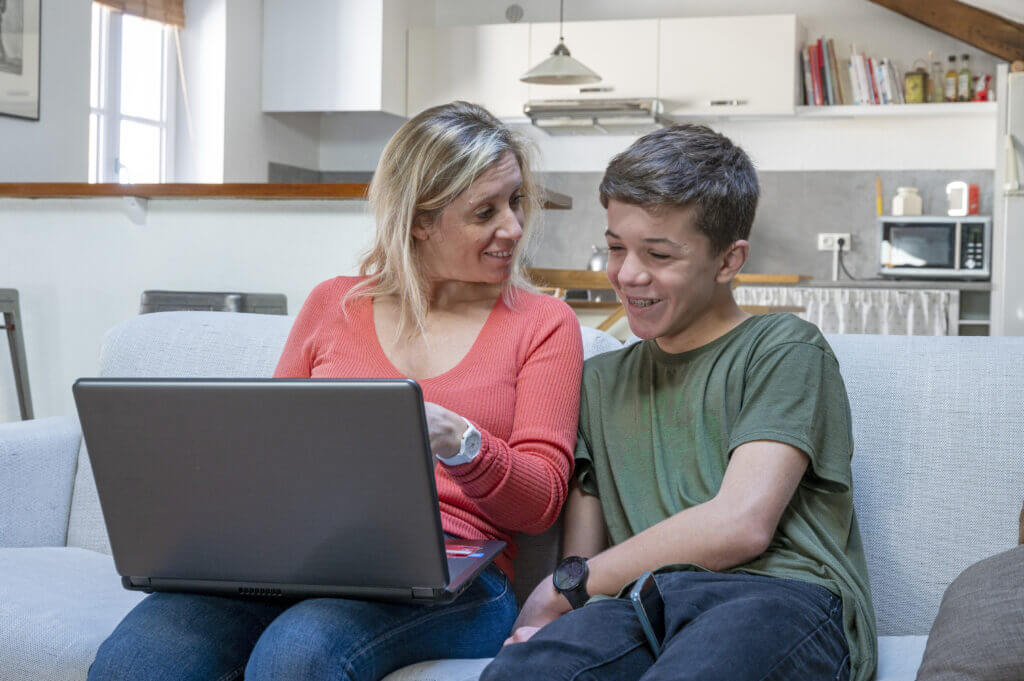Written by the ParentPowered team; edited by Maren Madalyn
Why is family engagement important?
Family-school partnerships are as critical to student success as classroom teaching itself. They have a positive effect on everything — from graduation rates to math and reading scores to teacher satisfaction and wellbeing. At the start of a new academic year, school districts often put a lot of time and energy toward introducing brand-new family engagement ideas to get parents involved in student learning and school programs. While great in intent, adding new programs can be quite challenging, time-consuming, and resource-intensive in practice.
But school leaders can actually improve home-to-school partnerships without reinventing their entire family engagement toolbox from scratch. To create more reciprocal and responsive family involvement practices, schools need only concentrate on existing resources and strategies — rethinking how they already engage parents and engage families to support a child’s education.

In essence, it’s about improving family engagement by doing things “differently” — and not more things.
Restrategizing family engagement may feel like a big undertaking. The good news is that there are fundamental, research-based principles of impactful family engagement programs that schools can leverage as they re-think their approaches to increase parent engagement.
Among these core tenants are:
- Include parents, caretakers, and guardians in decision-making about their child
- Create reciprocal communication between schools and families
- Expand the expertise of parents, caregivers, and guardians outside of the classroom.

What do great family engagement ideas look like?
So what does it look like when, instead of launching all new parent engagement strategies, educators focus on increasing family engagement through existing approaches and activities?
In this article ParentPowered explores how educators can rethink their connections with families, revitalize opportunities for family involvement, encourage participation and create long-lasting, trusting relationships with these critical community members.
Emphasize routines that build communication
Effective communication is the cornerstone of successful partnerships. Schools and families benefit from established and consistent communication routines between home and school. And one common routine that many schools have in place is the classic “take-home folder”.
So what would happen if educators re-examined the purpose of the “take home folder”? Could it become a way to both keep parents informed about the latest in their child’s education — and also to open doors for information to flow back into the classroom?
Heck yes, it can!
Stuffed with permission slips, graded work, and school announcements, this important tool is really best described as a “communication folder.” It offers teachers a great opportunity to cultivate positive relationships with families by cultivating two-way communication habits — practices that encourage parents to share back with school teams as much as educators reach out to families.
Teachers can try enclosing a pad of sticky notes and a pen in students’ communication folders. With practice, families can get into a regular habit of writing a note and sending it back to the classroom through their students’ backpacks. This simple but powerful habit can encourage families to open up to teachers about what’s happening at home or ask questions about their child’s learning experiences.
When sending written communications home with students, school faculty can also encourage parents to share feedback alongside requests for signatures, home information, and more. The goal here is to encourage deeper involvement among family members with their students’ current work. Here are a few sample questions to add to school forms when collecting parent feedback:
- Ask your child about the steps of this school project. What did they say?
- How did your child feel about their work this week?
- What does your child say when asked about the purpose and plan for this upcoming field trip (or other school events)?

Family input doesn’t just inform teachers’ understanding of their students. These conversation starters also subtly introduce opportunities for parents, caregivers, and guardians to contribute to student learning, and therefore student success, from home.
Download our communications tip sheet for more ways to craft outreach to families and build stronger relationships with trust and reciprocity.

Make the most of in-person time with families at school
Each time a parent sets foot in a school building is another chance to maximize their presence with more meaningful types of family engagement.
School teams can reflect on existing family participation opportunities held on campus and invite families to utilize tools in their family engagement toolbox to deepen these in-person connections. For example, how does a school community partner with families when they attend Back to School nights or volunteer for after school programs and similar events onsite? What activities do staff use to engage families during end-of-year ceremonies or even student performances?
When school administrators rethink their traditional family events programs, like parent-teacher conferences or family workshops, they stand a better chance of improving their effectiveness. Here are a few family engagement ideas to get creative with commonplace school events like on-site parent meetings, parent nights, family workshops, Open House, and more.
Curate non-academic learning stations
A well-designed learning station during an Open House offers a fun and unique experience for families to explore a variety of useful topics. Rather than share the usual “what kids will learn this school year”, educators can offer resources or information about parenting, communication with schools, and more. This is both a golden opportunity to educate parents on relevant topics and also offers a change of scenery that increases the value of families’ participation in school events. Last, and most crucially, these learning stations give educators space to build relationships with families.
Try setting up stations that demonstrate how to access online parent resources, raise awareness about upcoming events like a virtual literacy night, or invite community health workers to share ways for families to access critical resources. After all, families are far more likely to engage in school when their basic needs are met and supported.

Consider asking a family to host their own learning station, offering the expertise of parents back to other parents in the school community.
Create an inclusive space
An equitable and inclusive environment is critical for families to trust in and collaborate with their schools. Culturally responsive family engagement practices, especially when families are on campus, create a sense of trust and respect necessary for building relationships with parents, caregivers, and guardians.
Embracing linguistic diversity is important when nurturing an inclusive environment where every family feels understood and valued. For all school events, make sure to communicate to non-native English-speaking families what translation services are available. Organize any multilingual staff or parent volunteers available to translate so that they are obvious and easy for families to find — large name tags designating their language as in “Hablo Español” or “Tiếng Việt” are a great way to help staff stand out. Where needed, make families aware of any accessibility issues in advance of onsite events.
Providing parents, caregivers, and guardians with the necessary support during family engagement activities makes them feel welcome and signals that schools value their families. And this gesture goes a long way to building stronger relationships between home and school.
Want to offer a more inclusive, welcoming family engagement program? Reach out to discuss our professionally translated, culturally-responsive family engagement resources.
Consider informal meetings as connection moments
Less formal occasions also offer yet another opportunity to build connections with families. Family engagement ideas here center on building relationships and trust through smaller-sized communication practices between staff and school families. When parents drop off their kids at school or stop by the front office, staff can again take advantage of the moments on campus to cultivate said trust.
Consider providing professional development for faculty that helps them transform that informal meeting with a parent in the hallway into family engagement moments. Active listening practices are a great place to start cultivating positive relationships, which are key in the recipe for positive school climate.

Teachers are often the best messengers for sharing new learning ideas with families, too. For instance, teachers can recommend easy, everyday learning activities for families and students to do together during at-home routines — activities like those offered by ParentPowered. By encouraging greater parent involvement in small, fun ways at home, teachers strengthen parents’ muscles for supporting their children’s learning anytime, anywhere.
Take advantage of passive engagement opportunities
Not all forms of family engagement require active attention from educators. For a more passive form of outreach to families, try putting together a “Family Information Wall” with grab-and-go resources in school hallways. This strategy gives families another way to connect with schools whenever they are on campus. It also helps schools in turn better support the whole family unit, especially when these information walls feature family-centered services in their local community or other valuable community-based resources.

Give families a voice in your decisions
A parent’s voice is one of their most critical tools for supporting student learning. Family surveys and other feedback collection methods encourage families to share their perspectives about school. Whether schools are reflecting on family participation in various school activities and events or addressing concerns from the community about school health activities, family input in any area of school programming and at any time during a school year is invaluable.
For multilingual communities in particular, surveys offer a powerful way to engage parents and include families’ voices in school decisions — and families appreciate learning how their feedback has impacted the school environment. You can learn more about how feedback surveys engage your families in our recent webinar all about collecting family feedback from afar.
Bring family engagement activities to families
Virtual opportunities for families to listen to on-site school events offer an effective way to break through common barriers that affect school involvement among families, such as transportation, child care, and scheduling. When families can actively participate in a remote space, it creates an even more meaningful experience as parents feel like part of their community and children’s education, even when not physically present on campus.
For example, a lively and fully staffed chat in the virtual space encourages families attending remotely to ask questions or share comments during an event. Other virtual family engagement ideas include using polls, GIFs, live video, or other asynchronous media to make families feel heard without needing to be in the building.

To further bridge the gap and enhance family engagement, bringing school events into the community presents a unique opportunity to invite family members into their children’s educational journey in spaces where they feel most comfortable. Partnering with local businesses, parks, recreation centers, libraries, and community hubs not only makes events more accessible to families who may face logistical challenges but also taps into the heart of where community life thrives. This collaborative effort to involve families by hosting events in familiar, communal spaces not only increases the likelihood of participation but also strengthens the bond between schools and the communities they serve.
Imagine the impact of school-hosted family literacy nights at the local library, a science fair in the community park, or a family wellness day at the recreation center. These initiatives do more than just invite family members; they cultivate a welcoming environment that encourages active participation, fosters respect, and allows families to contribute towards a common educational objective. Family and community engagement in schools opens the space for greater collaboration between home and school — all in service of each child’s education.
What about families that cannot join an event either live or remotely?
Educators can still nurture their family relationships by offering a downloadable slideshow that covers the highlights of the event and making it widely available. At ParentPowered, we provide families with fun and easy activities to do with children at home at any time through our ParentPowered Workshops and Modeled Moments video series. These are just a few of the many ways to cultivate a higher level of family involvement and ensure they feel included in the community.
Be sure to consider what information needs to be delivered to families about a school event, as well as the desired experience for families. When thoughtfully designed, both virtual and on-campus approaches can increase family involvement and nurture relationships between home and school.
Build relationships with families through curated messaging
Crafting the right message for families is just as crucial as parent involvement itself. How a school communicates with its community can make a big difference in nurturing strong relationships with families.
Messaging is most effective when it is both written at an appropriate grade level and is consistently useful for families. Additionally, families appreciate shorter messages. But what’s the best way to actually send messages to families?

Research shows that there is no more effective means of communication with families than text messaging. Texts are often widely available for most families and have a higher read rate than email or written communication. Schools can use text messages to create opportunities for families to connect more easily with staff — and spark learning moments at home.
And that’s exactly what ParentPowered messages are designed to do! Our programs provide families with ways to support student learning outside the classroom and help schools build home-to-school partnerships — all without a heavier level of involvement by teachers, school leaders, or support staff.
Unlike other family engagement programs, ParentPowered’s curricula also scaffolds parent engagement with developmentally appropriate activities that support their child’s growth and learning at all stages of life. This differentiation is important — parents supporting high school students will participate in learning in very different ways from parents raising toddlers.
Explore our sample messages to see how our program “grows up” alongside students, from birth all the way up to grade 12.

Create strong family-school partnerships with ParentPowered
Improved family engagement doesn’t require new programs, increased parent volunteer opportunities, or more PTA meetings. Instead, school teams can re-examine and re-vitalize their existing family engagement ideas for creative ways to involve parents in their children’s education. The goal is to strengthen the connections between the classroom and home, without overstretching resources or overloading staff.
A great first step to enhancing family engagement ideas is to bring the family community to the table. Gather with parent organizations, school staff, and teacher leaders to reflect together on policies and programs for a thriving school community. Create a vision together that leverages your existing family engagement toolbox rather than starting from scratch.
Refined and co-created family engagement strategies will ultimately create better outcomes for the entire school community’s future success. This collaboration positions parents, caregivers, and guardians to feel like they are part of the broader school community. It also creates allies for school faculty to drive positive learning outcomes.
This is a foundation of family engagement: to build trusting partnerships that benefit students most!






